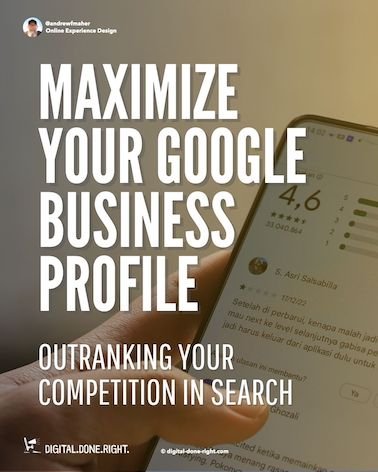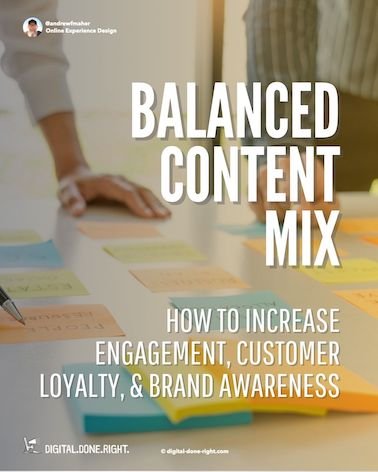Maximize Your Google Business Profile: Outranking Your Competition in Search
This is part 3 of a six-part series where I look into how to make your business more visible on the Internet. I give practical examples that you can immediately apply to your business. You can also find worksheets that will assist you in making your business make the most of your internet activities.
How can you optimize your Google Business Profile to outrank your competition in search?
What are some important factors to consider when filling out your profile, and how do they affect your ranking in search?
🇩🇪 Lieber auf Deutsch? Klick hier
Welcome back to my series on outranking your competition in search. This lesson may be the most important in the entire course.
As we learned previously, your Google Business Profile contains all the top ranking factors that determine your placement in the map rankings. In this lesson, I will walk you through optimizing your profile to 100% to get the most out of it. We will maximize each individual element, and I'll show you how to fill out your profile as completely as possible, as this is also a ranking factor.
I'm sure many of you already have a profile set up to some degree, but there are still optimizations you can make to improve its effectiveness. And for those who are new to business or have not yet set up a profile, we'll start there.
To claim your business profile, simply go to business.google.com enter your business name, and click "Manage Now."
If you have already set up your profile, make sure you are signed into Google with the email you used for the listing, then search for "My Business." This will bring up a small panel at the bottom of the page.
Google: Edit profile
Business Name
Is your keyword phrase included in your business name? This is a tricky question.
You cannot simply add keywords you want to rank for to the name of your business in your Google Business Profile. For example, if your business is called "Smith's Flowers" and you're trying to rank for the search term "wedding floral arrangements Wiesbaden," you cannot list it as "Smith's Wedding Floral Arrangements Wiesbaden" unless that is the actual name of your business. Otherwise, your listing may be removed, and that's not what you want. However, you could legally rebrand to a new name that includes those keywords or at least some of them to improve your ranking.
The pros of doing so are that you will likely rank higher on the maps, which could lead to more business. The cons include the possibility that your business name may sound spammy if not done correctly, and this may not be as big a ranking factor in the future. Therefore, if you choose to rebrand, it's important to ensure that the new name sounds good and like a real business. It's much harder to achieve this when you try to shoehorn in the name of your town, so I recommend against going that far with it.
Business Category
After researching the terms people are searching for, pick the category that is the closest match.
One easy way to do this is to type your keyword phrase and city name into Google and see who shows up in the top spots. From there, you can see what category they picked as their primary, which gives you a clue about what works best.
Google: Business Category and Description
Once you've selected the single best category as your primary, you can choose up to 10 additional keywords that are relevant to your business. Be careful not to choose categories that are unrelated to what you do, as this can lead to "category confusion" which can hurt your ability to rank for what you actually want to rank for.
Description
You can now craft a benefit-driven description of your business, highlighting the problem you solve or the services you offer, and emphasizing the results you provide your customers. Google has set a limit of 750 characters for your description, so it's important to carefully prioritize the details you want to include. Keep in mind that Google will only display the first 250 characters of your description.
Now add the following pieces of information:
Opening date
Phone
Website
Location
Previously, I discussed how your address affects your rankings. Here, you can input your physical address and/or your service area. For example, if you are a service business, you would add your service area here. To edit, click the pencil icon and make any necessary changes. Even if your address won't be shown, you still need to enter it in for Google to know you're a real business. Regardless of whether it's shown or not, Google uses this address when factoring in location-based ranking signals.
If you're a service business, you can specify your service area, but it doesn't affect your ability to rank within that area. It's just there for customers to see if you're willing to work with them in a particular location.
To fill in your service area, click into it and add any areas you're willing to work with customers in, such as cities, states, zip codes, or entire countries. If you'll be traveling to customers, be realistic and don't add areas in hopes of ranking in more places, as this won't help you.
It's worth noting that Google doesn't want service businesses to list their physical addresses, even though some competitors may do so. However, businesses that list their addresses generally rank higher. Whether or not to include your physical address is up to you, but consider the risks and rewards before making a decision, as it technically goes against the rules.
Business Hours
Assign your business hours and also set up which dates you are not open like public holidays. If your business has different hours for different services like for lunch and then for dinner, set those up as well. It is very frustrating when a business has the wrong information on its profile so make sure you make changes whenever your business changes.
Google: Business Hours
Photos
According to Google, listings with photos receive 35% more clicks through to their websites than businesses that don’t.
Adding photos that are highly relevant to your business type can help even more because Google's AI can "see" what's in the photo, and helps to strongly associate your business with your category.
Use a great cover photo that is high quality and 1024x576 pixels in size. Avoid using stock photos.
Use a square logo that is 720x720 pixels in size.
Include as many extra photos as you have that are relevant, such as photos showcasing your services, products, team members, interior, and exterior.
Products/Services
To improve your ranking for people looking for specific products or services, you should fill out as much information as possible. Adding images, pricing, and short descriptions for each product or service can be very helpful. Not only will it help your customers find what they're looking for, but it also demonstrates that you have a strong understanding of your products or services.
Google: Products
Furthermore, taking advantage of product listings can be a great way to improve your online presence. If you're a service business and you have access to product listings, I highly recommend using this instead of services. Google is fine with this, so you're not breaking any rules by doing it.
Appointment/Booking link
To make it easy for potential clients to book a meeting with you, it's recommended that you add an appointment or booking link to your Google Business Profile. This link should direct them to a page on your website where they can easily schedule a meeting at their convenience. By doing this, you make it more convenient for them to schedule a meeting with you, which can improve your chances of acquiring more clients.
Q&A
One of the most important things to do when running a business is to be available to your customers. To ensure that you are able to provide the best service possible, it's important to anticipate the questions that your customers may have and be prepared to answer them.
Here are some of the top questions that customers may call or email about:
What are your hours of operation?
What is your return policy?
How long does shipping take?
Do you offer any discounts or promotions?
How can I track my order?
It's important to have clear and concise answers to these questions readily available. By doing so, not only will you be able to provide better customer service, but you'll also be able to close more sales. In order to be able to answer customer queries in real time, it's a good idea to turn on notifications so that you're alerted as soon as a question comes in.
Posts/Updates
It's a fantastic way to showcase any events, offers, or updates you want to share with your audience. It allows your customers to stay informed about your brand and any new deals or promotions you may have. In my experience, running at least one offer is highly advisable, even if it's just for new customers who may be hesitant to try your product or service. By offering even a small promotion, you can entice them to give your brand a chance and hopefully become loyal customers in the long run.
Staying Up to Date
And that’s pretty much it. While there are a lot of steps involved, it really is pretty easy to just go through each category and complete each action item. And it’s generally good practice to keep everything updated, and current over time. Add new photos as you get them. Add new offers, and promotions from time to time as well. When you do that, Google knows you’re a real business that’s active and that you care enough to keep your customers updated, and that can go a long way in how they treat your listing.
Google: Set your holiday hours too
Google Health Check
I think it’s a good idea to do a little re-con up front to see how you’re ranking currently, so you can track your progress over time. And you COULD just google your keywords and see where you rank in the maps, but the problems with that are:
Google results are always a little different from person to person. If you’ve already been on your site a bunch of times, it’s likely to artificially inflate your ranking for YOU.
You’d only see your ranking position from wherever you do the search from. And since obviously, not everyone’s searching from the exact spot you’re sitting in right now, you want to go a step further and see where you stack up from various spots around town.








